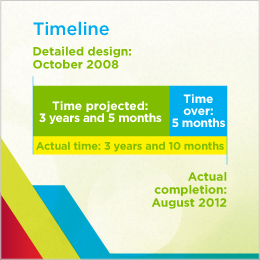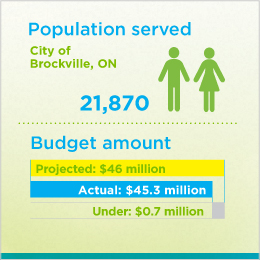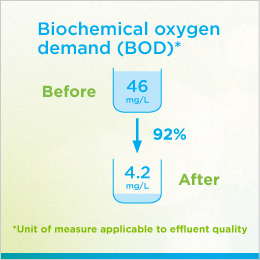This is part of a series of case studies on wastewater projects funded by the FCM's Green Municipal Fund. Each case study provides technical information, project details and tips on best practices.
Project overview
The City of Brockville, ON, upgraded its wastewater treatment facility to add secondary treatment using the conventional activated sludge process. The city also replaced the plant's chlorine disinfection system with an ultraviolet disinfection system.
The project team modified the facility to accommodate secondary treatment, improve control and monitoring, address existing shortfalls and make the facility more energy-efficient. The project improved control and monitoring with the addition of four automated sensors to monitor effluent turbidity, flow, pH and ammonia levels. The secondary treatment process includes energy-efficient technology and meets energy-efficiency standards of the LEED® rating system.



Reasons for the project
- The facility was non-compliant with Ontario Ministry of the Environment and Climate Change (MOECC) regulations for five-day biochemical oxygen demand (BOD) loading.
Innovative aspects of the project
- The project goes beyond regulatory requirements: the upgrades are designed to achieve much lower BOD and total suspended solids (TSS) and to reduce total phosphorous, fecal coliform counts and total ammonia.
- The building design meets energy-efficiency standards reflected in the LEED rating system.
Best practices and key lessons
The municipality's experience with this project demonstrates some best practices and key lessons that can inform similar projects.
Use integrated teams and processes
- The project team consulted operating staff directly and regularly throughout the preliminary detailed design process. Operating staff participated in site visits to view processes and equipment being evaluated. Their input helped to shape the project, and this fostered a sense of ownership.
Use effective communications and project management
- The city emphasized good oversight and management, retaining a project management firm to lead the process. This allowed the city to implement the project successfully without hiring additional staff and to benefit from the expertise of a number of individuals at the project management firm.
- Clear lines of communication and active coordination of the diverse parties involved are essential to the successful management and delivery of projects.

View of secondary clarifiers, pump and UV disinfection system. (Credit: City of Brockville)
Project benefits
This project yielded a number of environmental, social and economic benefits.
Environmental benefits
- Inclusion of renewable energy: The city installed a solar wall to heat the building.
- Improved wastewater quality: With the addition of secondary treatment, the plant now complies with MOECC standards. Four new automated sensors take measurements before and after secondary treatment, ensuring the quality of effluent (turbidity, flow, pH and ammonia levels) entering the St. Lawrence River.
- Reduced hazardous residuals: The city replaced the chlorine disinfection system with an ultraviolet system.
- Ecosystem protection: By improving the quality of the effluent discharged to the St. Lawrence River, the project promotes the health of the river, its wildlife and ecosystem.
Social benefits
- Improved public health: By improving the quality of the effluent discharged to the St. Lawrence River, the project promotes the health of Brockville residents and people living in neighbouring communities.
- Opportunities for recreational activities: By improving the quality of the effluent discharged to the St. Lawrence River, the project protects the health and safety of those who engage in recreational activities such as boating, swimming, fishing and scuba diving.
- Improved service delivery: With its expanded treatment capacity, the plant can better manage peak and excess loads for the residential, industrial, institutional and commercial premises it serves. With a new septage receiving facility, the community's septage can be treated locally.
Economic benefits
- Increased potential to attract new businesses: With added treatment capacity, the City of Brockville will be better able to serve current and future businesses.
- Increased potential to attract new residents: With added treatment capacity, the City of Brockville will be better able to serve a growing community.
- More efficient operation: Four automated sensors measuring effluent quality (turbidity, flow, pH and ammonia levels) are integrated with the SCADA (supervisory control and data acquisition) system to adjust the treatment process automatically to ensure quality levels are met.

Technical highlights
This project was a new facility. Technical highlights are current as of 2014.
Municipal population: 21,870
Urban/rural: urban
Treatment
- Before: Primary treatment
- After: Conventional activated sludge
Disinfection
- Before: Chlorine disinfection system
- After: UV disinfection system
Biosolids management
Annual average daily flow (AADF): 15.2 MLD (million litres per day)
Design capacity
- Before: 21.8 MLD
- After: 21.5 MLD
Per cent of total capacity used for AADF
- Before: 70 per cent
- After: 71 per cent
Total suspended solids (TSS)
- Before: 28 mg/L
- After: 7.1 mg/L
Project contact information
Conal Cosgrove
Director of Operations
City of Brockville, ON
T. 613-342-8772, ext. 8205
Want to explore all GMF-funded projects? Check out the Projects Database for a complete overview of funded projects and get inspired by municipalities of all sizes, across Canada.

